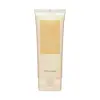What's inside
What's inside
 Key Ingredients
Key Ingredients

No key ingredients
 Benefits
Benefits

 Concerns
Concerns

 Ingredients Side-by-side
Ingredients Side-by-side

Cetyl Ethylhexanoate
EmollientWater
Skin ConditioningGlycerin
HumectantOlive Oil Glycereth-8 Esters
EmollientButylene Glycol
HumectantCitrus Aurantium Bergamia Fruit Oil
MaskingCitrus Nobilis Peel Oil
MaskingCoptis Japonica Extract
AntimicrobialEthylhexylglycerin
Skin ConditioningLavandula Angustifolia Oil
MaskingLimonene
PerfumingLinalool
PerfumingOlea Europaea Fruit Oil
MaskingPelargonium Graveolens Flower Oil
MaskingPolyacrylate-13
Polyisobutene
Polysorbate 20
EmulsifyingRosmarinus Officinalis Leaf Oil
MaskingSorbitan Isostearate
EmulsifyingPhenoxyethanol
PreservativeCetyl Ethylhexanoate, Water, Glycerin, Olive Oil Glycereth-8 Esters, Butylene Glycol, Citrus Aurantium Bergamia Fruit Oil, Citrus Nobilis Peel Oil, Coptis Japonica Extract, Ethylhexylglycerin, Lavandula Angustifolia Oil, Limonene, Linalool, Olea Europaea Fruit Oil, Pelargonium Graveolens Flower Oil, Polyacrylate-13, Polyisobutene, Polysorbate 20, Rosmarinus Officinalis Leaf Oil, Sorbitan Isostearate, Phenoxyethanol
Cetyl Ethylhexanoate
EmollientWater
Skin ConditioningGlycerin
HumectantOlive Oil Glycereth-8 Esters
EmollientPolysorbate 20
EmulsifyingButylene Glycol
HumectantSodium Acrylate/Sodium Acryloyldimethyl Taurate Copolymer
Emulsion StabilisingPolyisobutene
Hydroxyethyl Acrylate/Sodium Acryloyldimethyl Taurate Copolymer
Emulsion StabilisingArtemisia Capillaris Extract
1,2-Hexanediol
Skin ConditioningParfum
MaskingGlyceryl Caprylate
EmollientSorbitan Oleate
EmulsifyingEthylhexylglycerin
Skin ConditioningCaprylyl/Capryl Glucoside
CleansingMoringa Oleifera Seed Extract
Skin ConditioningSorbitan Isostearate
EmulsifyingOlea Europaea Fruit Extract
BleachingHelianthus Annuus Seed Oil
EmollientMacadamia Integrifolia Seed Oil
Skin ConditioningCoptis Japonica Root Extract
Skin ConditioningHydrogenated Lecithin
EmulsifyingPentylene Glycol
Skin ConditioningCaprylic/Capric Triglyceride
MaskingLeucine
Skin ConditioningButyrospermum Parkii Butter
Skin ConditioningPhytosterols
Skin ConditioningAlanine
MaskingAspartic Acid
MaskingPhenylalanine
MaskingIsoleucine
Skin ConditioningXanthan Gum
EmulsifyingLens Esculenta Seed Extract
Skin ProtectingGlycine
BufferingArginine
MaskingProline
Skin ConditioningSerine
MaskingGlutamic Acid
HumectantTaurine
BufferingHistidine
HumectantValine
MaskingMethionine
Skin ConditioningHydrolyzed Pea Protein
EmollientOrnithine
Skin ConditioningCaprylyl Glycol
EmollientSqualane
EmollientPolyglyceryl-10 Behenate/Eicosadioate
EmulsifyingSilica Dimethyl Silylate
EmollientPropanediol
SolventCeramide NP
Skin ConditioningCetyl Ethylhexanoate, Water, Glycerin, Olive Oil Glycereth-8 Esters, Polysorbate 20, Butylene Glycol, Sodium Acrylate/Sodium Acryloyldimethyl Taurate Copolymer, Polyisobutene, Hydroxyethyl Acrylate/Sodium Acryloyldimethyl Taurate Copolymer, Artemisia Capillaris Extract, 1,2-Hexanediol, Parfum, Glyceryl Caprylate, Sorbitan Oleate, Ethylhexylglycerin, Caprylyl/Capryl Glucoside, Moringa Oleifera Seed Extract, Sorbitan Isostearate, Olea Europaea Fruit Extract, Helianthus Annuus Seed Oil, Macadamia Integrifolia Seed Oil, Coptis Japonica Root Extract, Hydrogenated Lecithin, Pentylene Glycol, Caprylic/Capric Triglyceride, Leucine, Butyrospermum Parkii Butter, Phytosterols, Alanine, Aspartic Acid, Phenylalanine, Isoleucine, Xanthan Gum, Lens Esculenta Seed Extract, Glycine, Arginine, Proline, Serine, Glutamic Acid, Taurine, Histidine, Valine, Methionine, Hydrolyzed Pea Protein, Ornithine, Caprylyl Glycol, Squalane, Polyglyceryl-10 Behenate/Eicosadioate, Silica Dimethyl Silylate, Propanediol, Ceramide NP
Ingredients Explained
These ingredients are found in both products.
Ingredients higher up in an ingredient list are typically present in a larger amount.
Butylene Glycol (or BG) is used within cosmetic products for a few different reasons:
Overall, Butylene Glycol is a safe and well-rounded ingredient that works well with other ingredients.
Though this ingredient works well with most skin types, some people with sensitive skin may experience a reaction such as allergic rashes, closed comedones, or itchiness.
Learn more about Butylene GlycolCetyl Ethylhexanoate is an emollient ester. It comes from cetearyl alcohol and 2-ethylhexanoic acid.
Cetyl Ethylhexanoate is an emollient that adds a velvety feel to skin without being greasy or oily. Emollients help trap moisture into your skin, keeping your skin soft and hydrated.
Ethylhexylglycerin (we can't pronounce this either) is commonly used as a preservative and skin softener. It is derived from glyceryl.
You might see Ethylhexylglycerin often paired with other preservatives such as phenoxyethanol. Ethylhexylglycerin has been found to increase the effectiveness of these other preservatives.
Glycerin is already naturally found in your skin. It helps moisturize and protect your skin.
A study from 2016 found glycerin to be more effective as a humectant than AHAs and hyaluronic acid.
As a humectant, it helps the skin stay hydrated by pulling moisture to your skin. The low molecular weight of glycerin allows it to pull moisture into the deeper layers of your skin.
Hydrated skin improves your skin barrier; Your skin barrier helps protect against irritants and bacteria.
Glycerin has also been found to have antimicrobial and antiviral properties. Due to these properties, glycerin is often used in wound and burn treatments.
In cosmetics, glycerin is usually derived from plants such as soybean or palm. However, it can also be sourced from animals, such as tallow or animal fat.
This ingredient is organic, colorless, odorless, and non-toxic.
Glycerin is the name for this ingredient in American English. British English uses Glycerol/Glycerine.
Learn more about GlycerinOlive Oil Glycereth-8 Esters is an oil and isn't fungal acne safe.
Polyisobutene is a synthetic polymer made from isobutene.
It is a film-forming agent and helps bind ingredients together.
Polyisobutene is not absorbed by the skin.
Learn more about PolyisobutenePolysorbate 20 is made by combining ethoxylation of sorbitan, ethylene oxide, and lauric acid. It is a mild cleansing agent, surfactant, and emulsifier.
As a surfactant, it helps collect dirt and oils for washing. Emulsifiers prevent oils and water from separating.
Polysorbate 20 also adds scent to a product. Since it is made using sorbitol, it has a sweet scent. Sorbitol can also be found in fruits such as apples and peaches.
The lauric acid used to create Polysorbate 20 is often derived from coconuts.
Polysorbate 20 may not be fungal acne safe.
Learn more about Polysorbate 20Sorbitan Isostearate is an emulsifer and cleaning agent. It is created from isostearic acid and sorbitol.
As an emulsifier, Sorbitan Isostearate prevents oils and water from separating.
Due to its isostearic acid base, it may not be safe for Malassezia or fungal acne.
Learn more about Sorbitan IsostearateWater. It's the most common cosmetic ingredient of all. You'll usually see it at the top of ingredient lists, meaning that it makes up the largest part of the product.
So why is it so popular? Water most often acts as a solvent - this means that it helps dissolve other ingredients into the formulation.
You'll also recognize water as that liquid we all need to stay alive. If you see this, drink a glass of water. Stay hydrated!
Learn more about Water